Intel Xeon Gold 6152 Benchmarks
For this exercise, we are using our legacy Linux-Bench scripts which help us see cross-platform “least common denominator” results we have been using for years as well as several results from our updated Linux-Bench2 scripts. At this point, our benchmarking sessions take days to run and we are generating well over a thousand data points. We are also running workloads for software companies that want to see how their software works on the latest hardware. As a result, this is a small sample of the data we are collecting and can share publicly. Our position is always that we are happy to provide some free data but we also have services to let companies run their own workloads in our lab, such as with our DemoEval service. What we do provide is an extremely controlled environment where we know every step is exactly the same and each run is done in a real-world data center, not a test bench.
We also wanted to note that our dataset is focused on pre-Spectre and Meltdown results at this point. Starting with our Ubuntu 18.04 generation of results we will have comparison points to the new reality. The Spectre and Meltdown patches to hurt Intel’s performance in many tests. At the same time, as of writing this article, patches are still being worked on. Likewise, software is being tuned to deal with the impacts of the patches. Given this, we are going to give the ecosystem some time to settle before publishing new numbers.
Python Linux 4.4.2 Kernel Compile Benchmark
This is one of the most requested benchmarks for STH over the past few years. The task was simple, we have a standard configuration file, the Linux 4.4.2 kernel from kernel.org, and make the standard auto-generated configuration utilizing every thread in the system. We are expressing results in terms of compiles per hour to make the results easier to read.
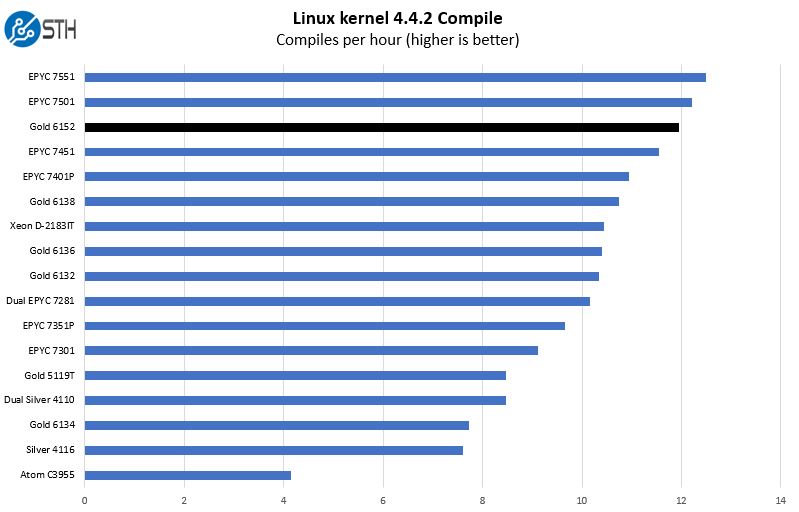
Here the Intel Xeon Gold 6152 falls just behind the EPYC 7501 which is around $300 less expensive than the Xeon. Still, one can see solid performance from the 22 core part. When people talk about how Intel Xeon Gold can exhibit better single-threaded performance than AMD EPYC, this is a good example. There is a single digit percentage variance despite the EPYC part having ten more cores.
c-ray 1.1 Performance
We have been using c-ray for our performance testing for years now. It is a ray tracing benchmark that is extremely popular to show differences in processors under multi-threaded workloads. We are going to use both our legacy 4K result along with our new Linux-Bench2 8K render to show differences.
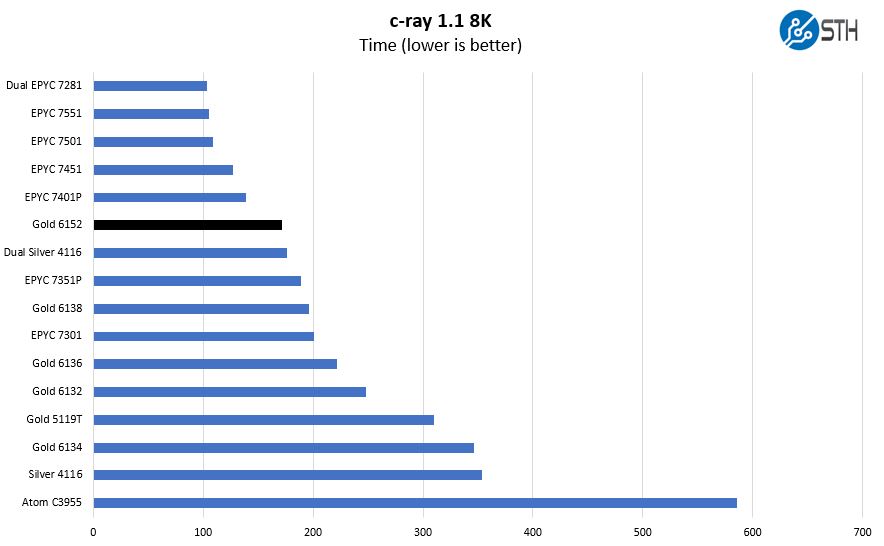
AMD performs extremely well in this chart, but we wanted to draw attention to the dual Intel Xeon Silver 4116 result. These runs are very sensitive to core counts and do not tax multiple NUMA nodes heavily as the application runs localized in caches. The 22 core Intel Xeon Gold 6152 performs better than 2x 12 core (24 total) Xeon Silver 4116 cores.
7-zip Compression Performance
7-zip is a widely used compression/ decompression program that works cross-platform. We started using the program during our early days with Windows testing. It is now part of Linux-Bench.
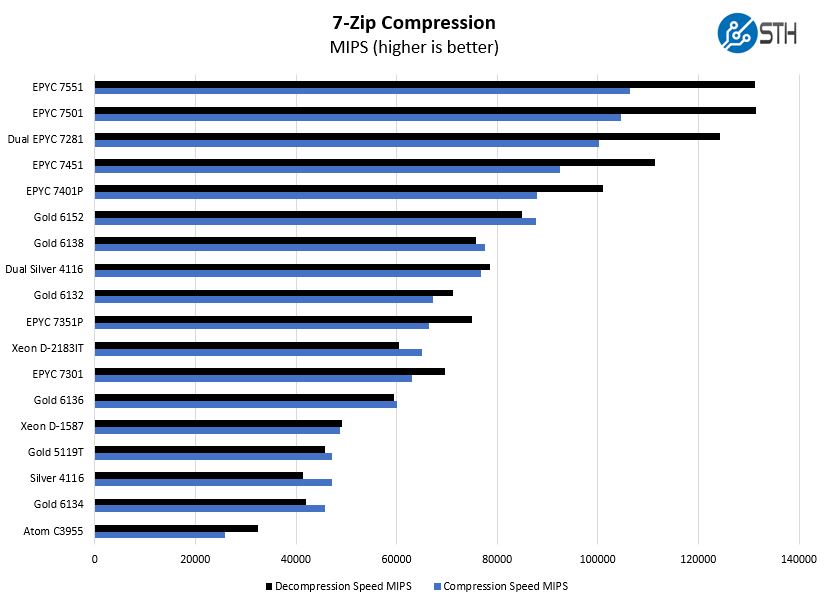
Here we can see a nice performance gain over the Intel Xeon Gold 6138 with its 20 cores. You can also see that the Intel Xeon Gold 5119T is left behind since it is the lower tier Xeon Gold.
NAMD Performance
NAMD is a molecular modeling benchmark developed by the Theoretical and Computational Biophysics Group in the Beckman Institute for Advanced Science and Technology at the University of Illinois at Urbana-Champaign. More information on the benchmark can be found here. We are going to augment this with GROMACS in the next-generation Linux-Bench in the near future. With GROMACS we have been working hard to support Intel’s Skylake AVX-512 and AVX2 supporting AMD Zen architecture. Here are the comparison results for the legacy data set:
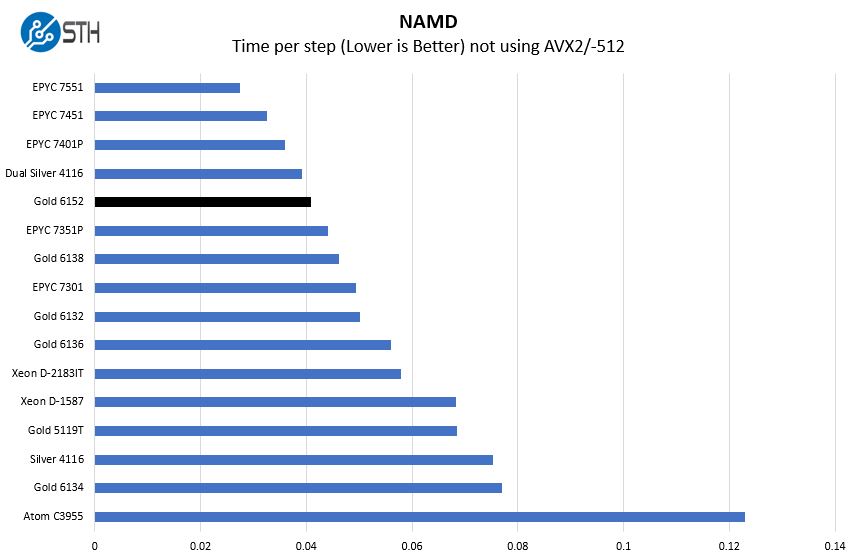
On the NAMD side, the Intel Xeon Gold 6152 performs relatively well compared to the other Xeon offerings. This will change when we look at the GROMACS results where the dual FMA AVX-512 units can show their performance.
Sysbench CPU test
Sysbench is another one of those widely used Linux benchmarks. We specifically are using the CPU test, not the OLTP test that we use for some storage testing.
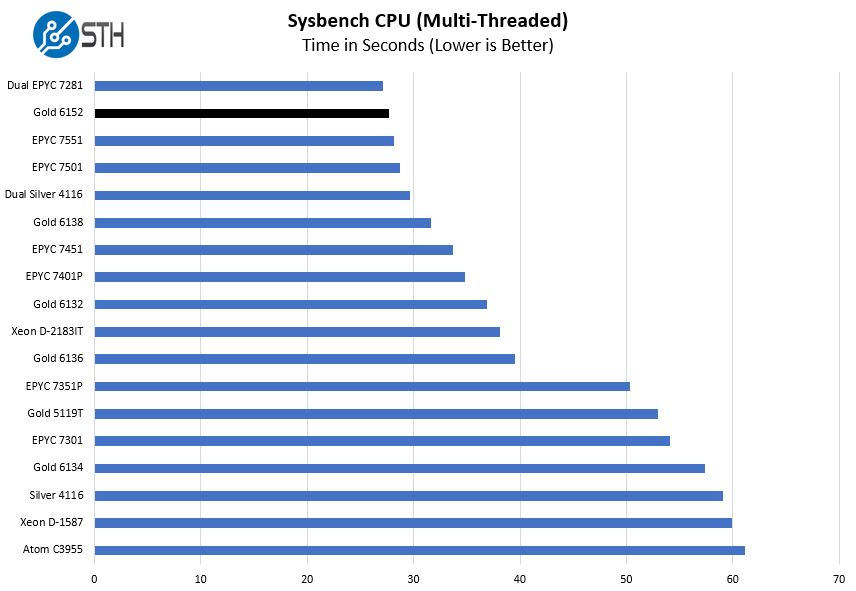
Here the Intel Xeon Gold 6152 is able to best the AMD EPYC 7501 and 7551. A somewhat surprising result is that the dual AMD EPYC 7281 (2x 16 cores) performs very well here.
OpenSSL Performance
OpenSSL is widely used to secure communications between servers. This is an important protocol in many server stacks. We first look at our sign tests:
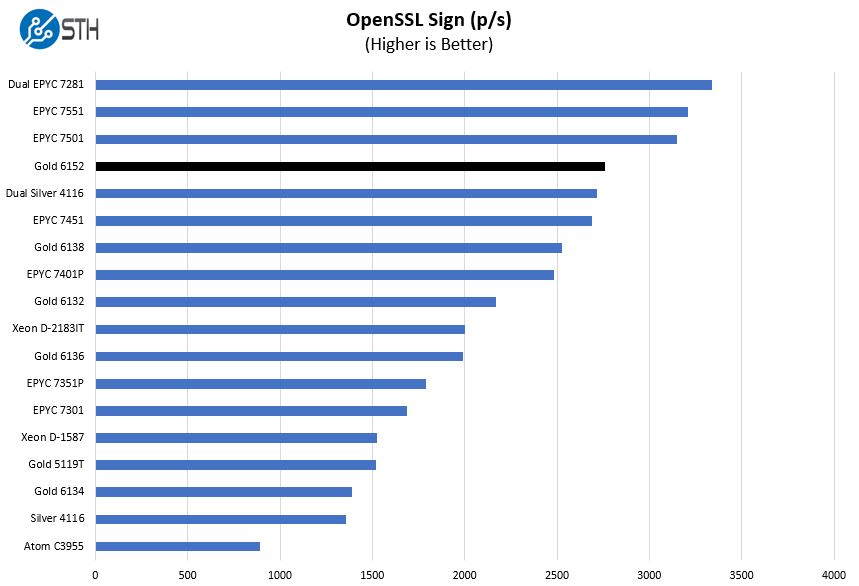
here are the verify results:
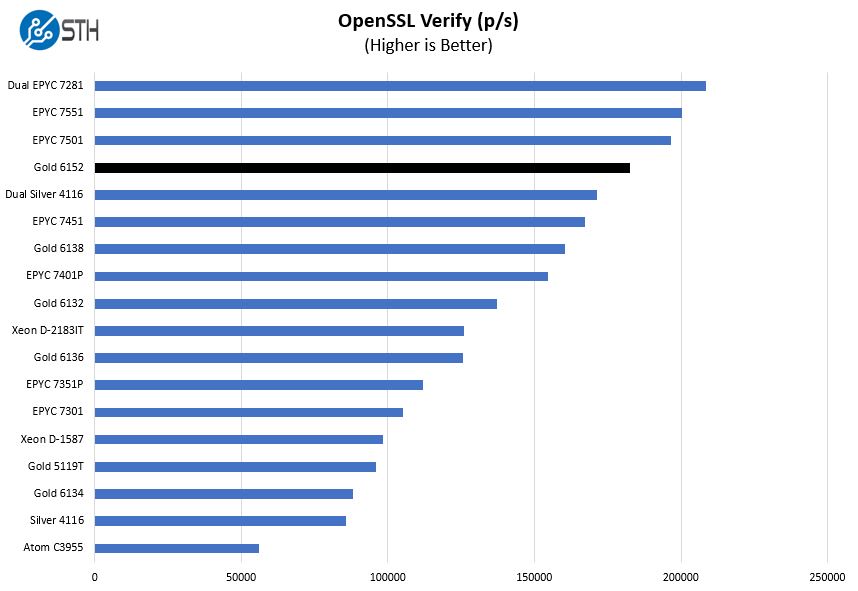
With its 22 cores, the Intel Xeon Gold 6152 performs better than the dual Intel Xeon Gold 4116 CPUs and easily outpaces the 24 core AMD EPYC offerings like the AMD EPYC 7451. This is one of those tests where the 32 cores of the higher-end AMD EPYCs perform well.
UnixBench Dhrystone 2 and Whetstone Benchmarks
Some of the longest-running tests at STH are the venerable UnixBench 5.1.3 Dhrystone 2 and Whetstone results. They are certainly aging, however, we constantly get requests for them, and many angry notes when we leave them out. UnixBench is widely used so we are including it in this data set. Here are the Dhrystone 2 results:
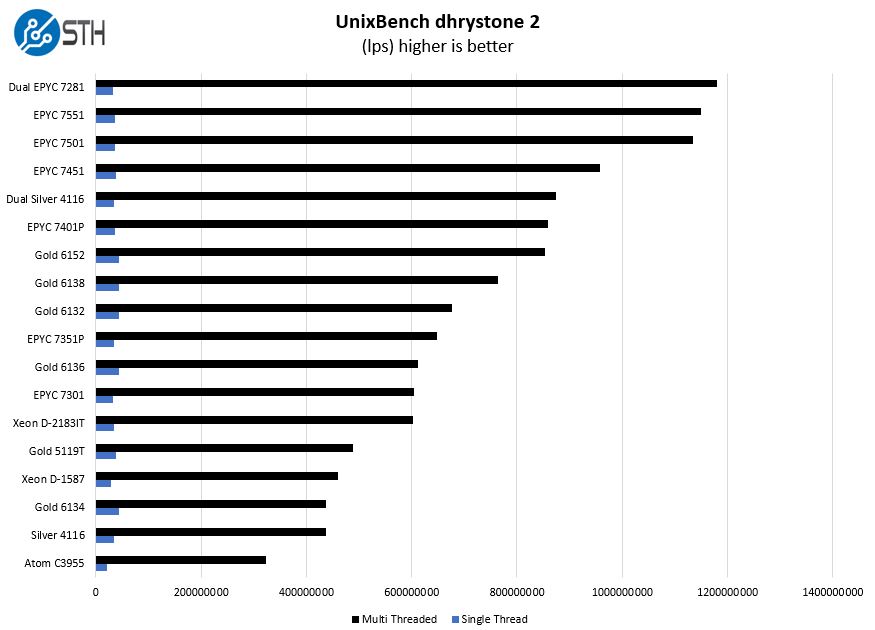
Here are the whetstone results:
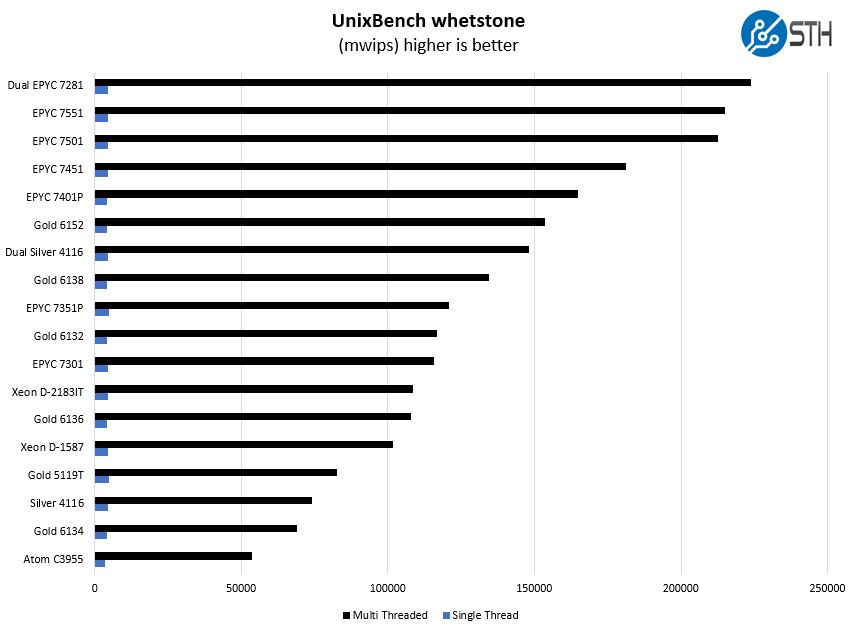
There is not much so say here outside of the fact that the Intel Xeon Gold 6152 is where we expect it to be in the Xeon SKU stack and that the AMD EPYC chips perfom well.
GROMACS STH Small AVX2/ AVX-512 Enabled
We have a small GROMACS molecule simulation we previewed in the first AMD EPYC 7601 Linux benchmarks piece. In Linux-Bench2 we are using a “small” test for single and dual socket capable machines. Our medium test is more appropriate for higher-end dual and quad socket machines. Our GROMACS test will use the AVX-512 and AVX2 extensions if available.
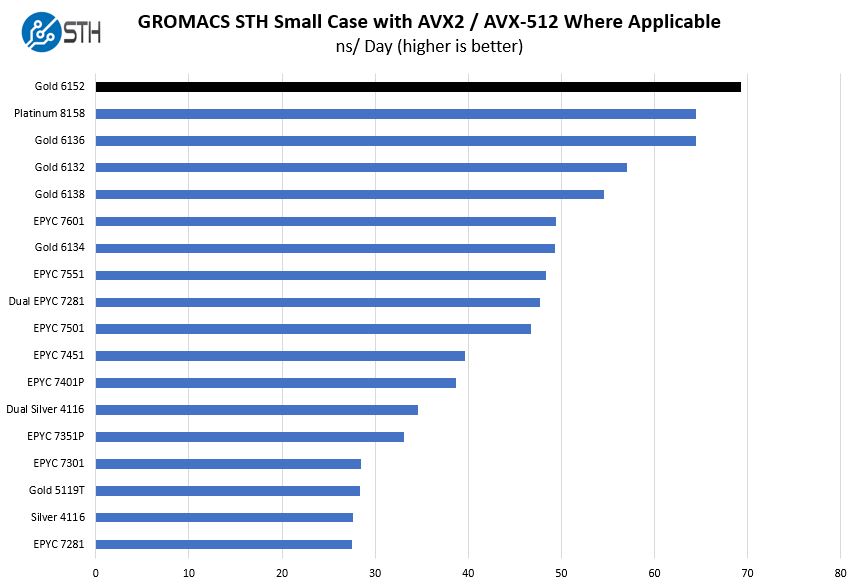
Once the dual port FMA AVX-512 units get going in our GROMACS benchmark, the Intel Xeon Gold 6152 pushes into its own class. It outpaces every other point of comparison by a wide margin.
Chess Benchmarking
Chess is an interesting use case since it has almost unlimited complexity. Over the years, we have received a number of requests to bring back chess benchmarking. We have been profiling systems and are ready to start sharing results:
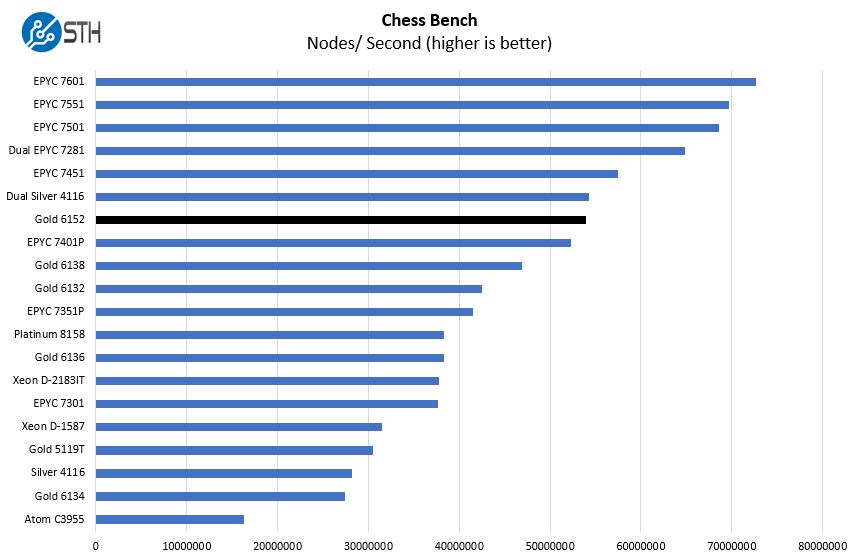
This is much closer to a stack ranking in terms of the number of cores in each system. The Intel Xeon Gold 6152 performs well, and ahead of the 24 core AMD EPYC 7401P.
Next, we are going to look at the Intel Xeon Gold 6152 power consumption along with market positioning. We will then provide our concluding thoughts on the CPUs.




Wow, AMD EPYC leading in almost every benchmark category and not always needing the top-end 32 core to get it done.
Patrick, for your power results, what is the difference between 100% and peak? What are you stressing differently to achieve peak?
Guys, pleeeeaaase consider adding cryptonight mining hashrates as standard part of benchmarking CPUs+GPU’s